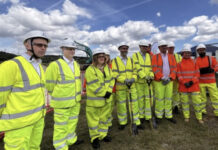Wildflowers growing on land previously used for buildings and factories can accumulate lead, arsenic and other metal contaminants from the soil, which are consumed by pollinators as they feed, a new study has found.
The metals have previously been shown to damage the health of pollinators, which ingest them in nectar as they feed, leading to reduced population sizes and death. Even low nectar metal levels can have long-term effects, by affecting bees’ learning and memory – which impacts their foraging ability.
Researchers have found that common plants including white clover and bindweed, which are vital forage for pollinators in cities, can accumulate arsenic, cadmium, chromium and lead from contaminated soils.
Metal contamination is an issue in the soils of cities worldwide, with the level of contamination usually increasing with the age of a city. The metals come from a huge range of sources including cement dust and mining.
The researchers say soils in cities should be tested for metals before sowing wildflowers and if necessary, polluted areas should be cleaned up before new wildflower habitats are established.
The study highlights the importance of growing the right species of wildflowers to suit the soil conditions.
Reducing the risk of metal exposure is critical for the success of urban pollinator conservation schemes. The researchers say it is important to manage wildflower species that self-seed on contaminated urban land, for example by frequent mowing to limit flowering – which reduces the transfer of metals from the soil to the bees.
Dr Sarah Scott in the University of Cambridge’s Department of Zoology and first author of the report, said: “It’s really important to have wildflowers as a food source for the bees, and our results should not discourage people from planting wildflowers in towns and cities.
“We hope this study will raise awareness that soil health is also important for bee health. Before planting wildflowers in urban areas to attract bees and other pollinators, it’s important to consider the history of the land and what might be in the soil – and if necessary find out whether there’s a local soil testing and cleanup service available first.”







